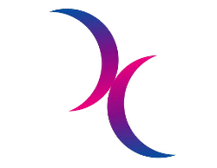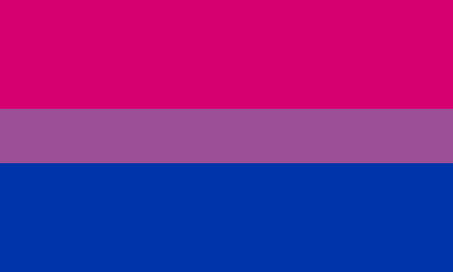bi-the-way.com

The Bisexual Umbrella
An umbrella term is a word or phrase covering a broad range of related things that are different from each other but all belong to the same category. Bisexuality is an umbrella term encompassing a wide range of identities, labels, terms and attractions that all fit the scientific definition of bisexuality.
Just as there are millions of ways to be straight, gay/lesbian, or asexual, there are as many ways to be bi as there are bi people. No one word can fully capture the nuances of personality, culture, beliefs, or personal preference; no word should try to. The term bisexuality makes no such pretense— it is a general and inclusive term that encompasses everyone; all sexes and all genders. That does not mean that bi people are attracted to everyone, simply that bi people’s attractions aren’t limited by sex or gender.
Some people under the bi umbrella use different labels to describe their sexual orientation, such as polysexual (attraction to multiple genders, but not all), pansexual (attraction to those of any or all genders; attraction regardless of gender) and omnisexual (attraction to those of all genders, with gender playing a role in that attraction).
Some people prefer the term fluid meaning that attractions do not fit into any neat category, and may shift while including people of more than one gender over time. These labels can be used by themselves or as additional descriptors. Some people feel that their sexuality, while not limited by sex or gender, is best left unlabeled because it is not central to their sense of self.
If these terms all seem to mean the same thing, that is because they basically do! Still, these words have value in that they allow people to describe their sexuality in ways that feel more comfortable or precise. They allow people to express their identity; how they see and understand themselves and want to be seen by others.
It’s helpful to note that although anyone who experiences both homosexual (same/similar-gender) and heterosexual (different-gender) attractions is bisexual according to the scientific definition, that does not mean that they will label themselves or even think of themselves (identify) as bi.
Some people benefit from using these labels instead of bisexuality, but others do not. These labels exist to describe specific experiences that a bi person may experience, but that does not mean that everyone wants to use them or even feels comfortable using them.
Bisexuality is broad and encompasses many different experiences. There is no one clear-cut definition of bisexuality, as it is often personally defined in ways unique to one’s own individuality. Telling a bisexual person they're actually another label because of how they experience their sexuality erases the inherent fluidity of bisexuality and the diversity of the bi community.
While labels like pan, omni, and poly may sometimes be included in bisexuality and may be used synonymously with bisexual, this does not mean pan/omni/poly people have to consider themselves bi or identify as such and vice versa with bisexuals and labels like pan/omni/poly.
It is ultimately up to the individual to decide what they feel most comfortable identifying as or which label they connect to the most, and that can be bisexual, any other label. Some people even identify with multiple labels and use them interchangeably.
Bisexual+ or Multisexual: An encompassing term for people with the capacity to be attracted to multiple genders and sexes. The bi+ community includes anyone who identifies as bisexual, pansexual, omnisexual, polysexual, fluid, queer, other labels or even unlabeled. This may also be referred to as mspec (short for multisexual spectrum).
Sources: Bi.org
Bi Resource Center
Mspec Labels and Definitions
Human Rights Campaign
Personal and Political Labels
The Trevor Project
bi-the-way.com
Biphobia
Biphobia: Biphobia is dislike, aversion, prejudice and negative beliefs and actions about and against bi+ people, including the denial and erasure of bisexuality and similar identities.
Biphobia is based on and rooted in binary views of sexuality and the idea that only monosexual identities are stable or real. Biphobia creates discrimination and prejudice against bi+ people, bisexual erasure (from media, literature etc.) and the social isolation, denial, dismissal and lack of acceptance that causes high rates of mental health issues in, abuse and ipv towards bi+ people, and causes barriers to accessing proper and affective treatment and support.
Biphobia creates violence and poor living conditions.
As a result of the stereotype that bi people have no sex boundaries, around 50% of bi women end up as rape victims, and bi men are more likely to experience sexual abuse than straight women.
Due to stereotypes that Bi people are inherently cheaters and thus will need their partners to “keep a constant eye on them.”, bis have disproportionately high rates of getting stalked.
Bi people are more likely to end up poor and homeless because despite making up the majority of the LGBT community, they are granted the least amount of resources needed to sustain.
With all the stigma surrounding bisexuality in both straight and lgbtq communities, alongside the high rates of abuse, and lack of emotional support that helps bi people figure themselves out, it’s not surprising that bi people are also usually unlikely to come out to their intimate family and friends as bi.
Biphobia manifests in many different ways including but not limited to interpersonally, culturally, structurally and internally.
Statistics:
Bisexual women are more likely to face abuse than any other women in the lgbt community
22% of bisexual women have been raped by an intimate partner, compared to 9% of straight women
Almost 30 percent of bisexual women and bisexual trans people live in poverty
The bisexual community is more likely to be unemployed, on welfare and in poor health
Bisexual people have disproportionately high rates of getting stalked and harassed
Bisexual youth are 2x more likely as non-LGBT youth to experiment with drugs and alcohol.
more than 40% of of bi+ youth have been mocked by their families for being LGBTQ.
Learn More About Biphobia:
What is Biphobia?
Bisexual Fact Sheet
Biphobia: It Goes More Than Two Ways
Bisexual Erasure
Biphobia and Monosexism
Bisexuality and Women
Bisexual Mental Health
Bisexual Health Disparities
Bisexuality and health: The cost of invisibility
Invisible Majority: Disparities Facing Bisexual People and How To Remedy Them
Bisexual Invisibility: Impacts and Recommendations
Snapshot: Bisexual In America
Bisexual Youth Report
Understanding Issues Facing Bisexual Americans
Legally Bi: A Brief History of Bi Erasure in LGBTI Political Discourse
Bi+ youth: bullying & interpersonal violence
Bi+ Youth of Color
Bisexual+ & Transgender Youth: Info and Issues
A Closer Look: Bisexual Transgender People
Why Do Bi Women Face Higher Rates of Sexual Violence
Bisexual Women and Sexual Violence
Why Bi Women Are at a Higher Risk for Violence
Intimate Partner Violence and LGBT People
Why So Many Bisexuals are Victimized
How Biphobia Impacts Black Bisexual Men's Health
Victimization By Sexual Orientation
Bisexual Experiences and Inclusion
Bisexual Issues
bi-the-way.com

The Bisexual Pride Flag
The Bisexual pride flag was designed and created by a team led by Bisexual activist Michael Page in 1998. Page wanted to give the bisexual community its own symbol and increase the visibility of bisexuals, in society as a whole and within the LGBT+ community. He designed the flag to be similar in color, pattern and overlap to the bi angles/bisexuality triangles and the bi moons symbol.
The pink color represents attraction to same and similar genders, the blue represents attraction to the different genders the resultant overlap color purple represents the overlap of this attraction and attraction across the sexual and gender spectrum.
Page states, “The key to understanding the symbolism in the Bi Pride Flag is to know that the purple pixels of color blend unnoticeably into both the pink and blue, just as in the "real world" where bi people blend unnoticeably into both the gay/lesbian and straight communities.”
Sources: The History of the Bi Pride Flag by Michael Page